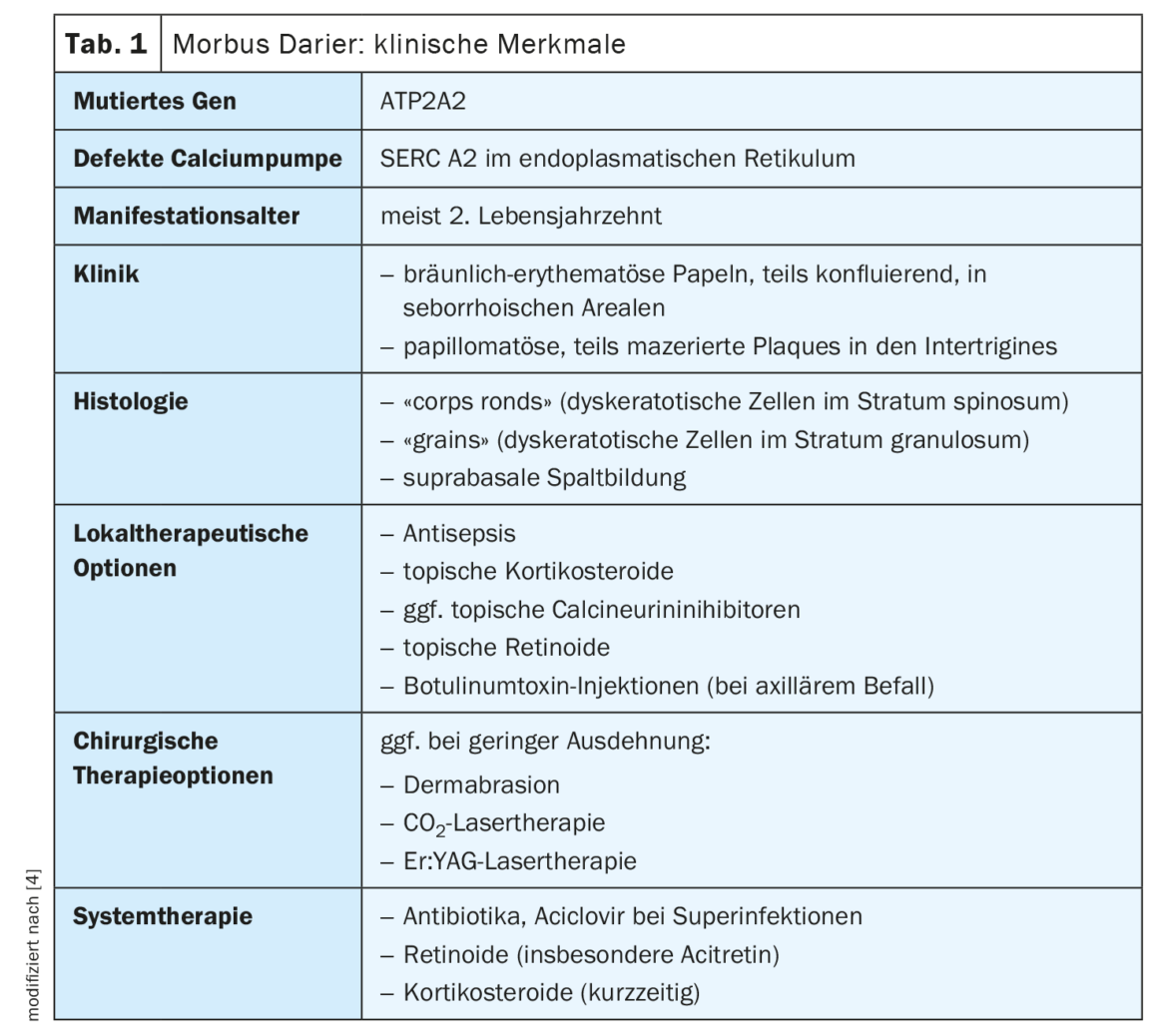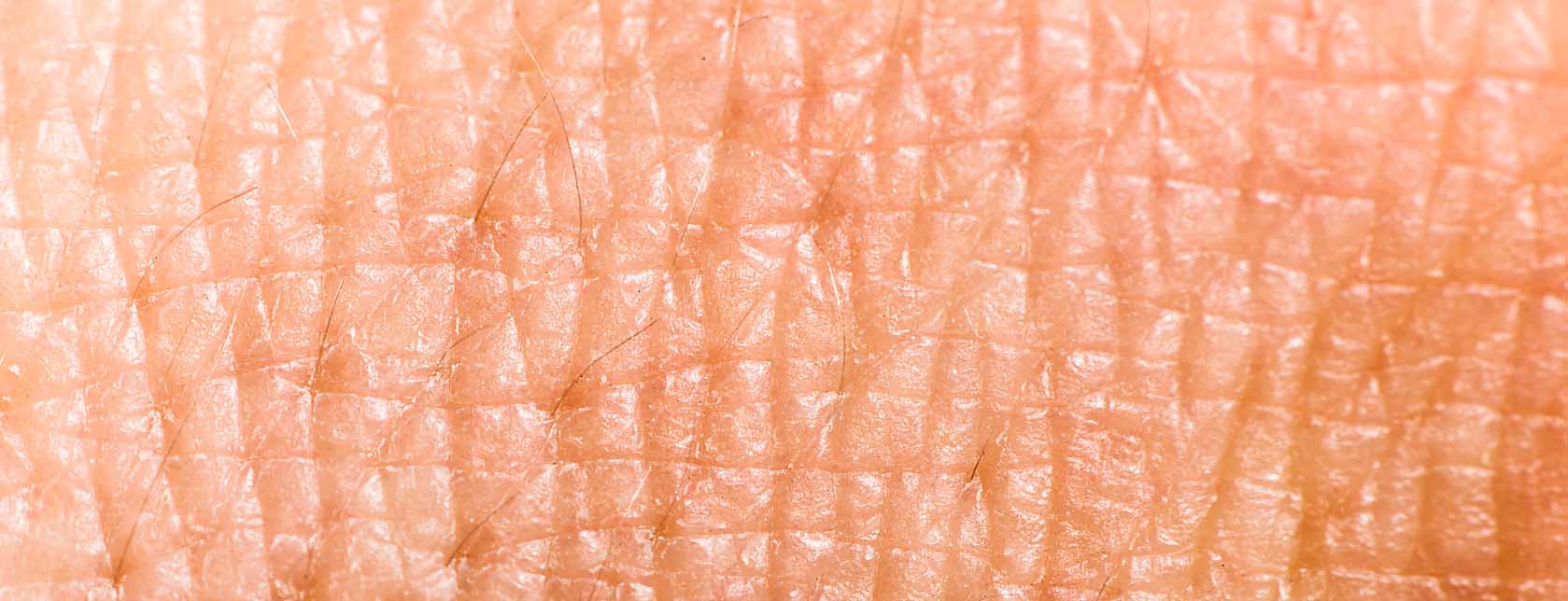The disease, also known as dyskeratosis follicularis, is associated with impaired keratinization of the epidermis, hair follicles and fingernails. Histologically, Darier’s disease is characterized by marked dyskeratosis. Therapeutic options are limited; in addition to antiseptic and keratolytic measures, there are several other treatment strategies.
Darier’s disease is one of the autosomal dominant genodermatoses caused by a mutation of the ATP2A2 gene on chromosome 12 [1]. The first description was made by Ferdinand Jean Darier in 1889 [2]. Clinically, dyskeratotic papules manifest, usually in seborrheic and intertriginous areas, which may confluence to form large lesions [3,4]. Longitudinal red and white stripes typically appear on the nails, culminating in a V-shaped notch at the free edge of the nail [4]. Whitish papules may form on the mucous membranes of the cheeks and hard palate [5].
The diagnosis is made clinically on the basis of the papules and is supported by the histopathologic picture [5]:
- Papillomatosis: Enlargement and coarsening of the papillae of the connective tissue projecting into the epidermis, which secondarily lead to a wavy unevenness of the skin surface via thickening.
- Acanthosis, hyperkeratosis
- Focal acantholytic dyskeratosis: premature single-cell keratinization in the form of so-called “corps ronds” in the stratum spinosum and “grains” in the stratum corneum
In the treatment of Darier’s disease, antiseptic measures are essential to prevent superinfection [4]. This includes avoiding trigger factors (heat, friction, sweat) to minimize microbial colonization [6]. Depending on the skin condition, urea-containing topical preparations are useful as keratolytic measures [6]. In addition, topical corticosteroids and systemic therapeutics (e.g., acitretin) are used [6]. Initially, for example, 25 mg acitretin p.o. is administered; this should be reduced to a maintenance dose of 10 mg p.o. during the course of treatment. [6]. Ablative therapies (dermabrasion,CO2 laser, Er:YAG laser) are also effective, but limited by the size of the treatable areas [4].
In order to collect “real life” data on diagnosis, treatment, and disease progression, a prospective clinical registry on Darier’s disease and Hailey-Hailey disease was initiated in Germany under the direction of PD Alexander Zink, MD, TU Munich [6].

Case study
A 53-year-old woman presented to the clinic with a more than ten-year history of keratotic papules [7]. The papules were located on the backs of the hands and feet. The toenails and fingernails were also affected. Skin-colored papules several millimeters in size were seen on the nose, scalp, and ears, clearly demarcated from the healthy skin. Keratotic papules were present on the lower back, including the perineum and vulvar region. Oral lesions manifested as white papules with a central depression. Based on the clinical presentation, possible diagnoses included Darier’s disease, Hailey-Hailey disease, Bazex syndrome, ichthyosiform dermatosis, Langerhans cell histiocytosis, or severe atopic dermatitis. Histopathologic findings on a biopsy revealed the presence of epidermal acanthosis, premature keratosis, and suprabasal acantholysis. The floor of the suprabasal cleft showed an accumulation of dyskeratotic cells. A multidisciplinary team classified a group of dyskeratotic cells reflecting acantholysis and premature keratosis as keratosis follicularis and a diagnosis of Darier’s disease was reached [7].
Literature:
- Haber RN, Dib NG: Management of Darier disease: A review of the literature and update. Indian J Dermatol Venereol Leprol 2021; 87: 14-21.
- Wikiderm, www.wikiderm.de/resources/pdf/Darier,%20Morbus.pdf,(last accessed 04/11/2023).
- Morelló-Vicente A, et al: Treatment of refractory facial Darier’s disease with photodynamic daylight therapy. JDDG 2022; 20(12): 1633-1635.
- Rogner DF, et al: Darier’s disease and Hailey-Hailey disease: status 2021. JDDG 2021; 19(10): 1478-502.
- “Darier’s Disease,” https://flexikon.doccheck.com/de/Morbus_Darier,(last accessed Apr. 11, 2023).
- “German clinical registry: therapy and medical care of patients with Darier’s disease and Hailey-Hailey,” 2019, version 1.0, www.derma-allergie.med.tum.de/fileadmin/user_upload/MDHH_
Register_Study_Protocol.pdf, (last accessed 04/11/2023). - Ferizi M, et al: A Rare Clinical Presentation of Darier’s Disease. Case Reports in Dermatological Medicine 2013, Article ID 419797 , www.hindawi.com/journals/cridm/2013/419797,(last accessed 04/11/2023).
DERMATOLOGY PRACTICE 2023; 33(2): 24











